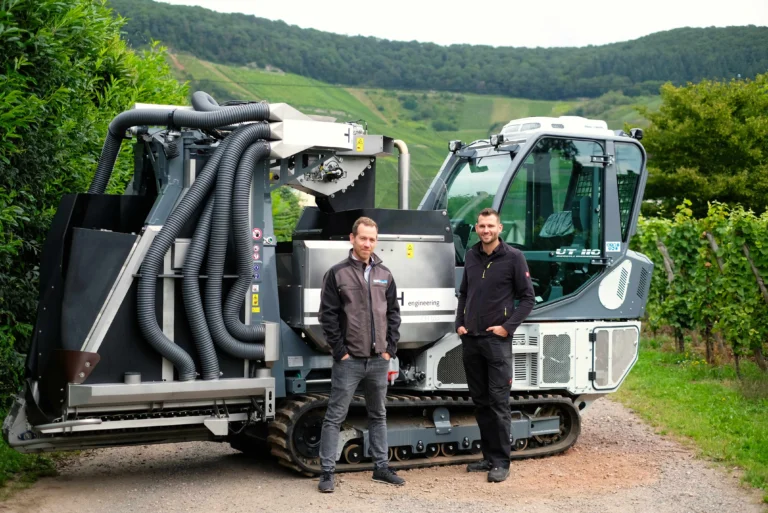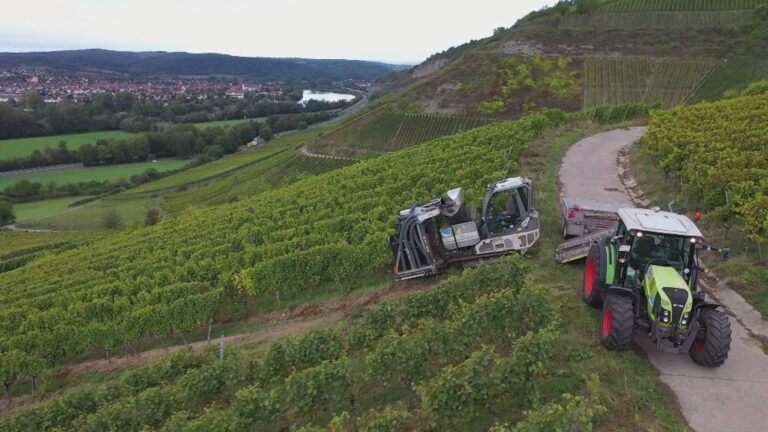- Harvester for steepest slopes changes labor equation for hillside vineyards
- Debut may represent the biggest equipment evolution/revolution in Napa/Sonoma in a decade.
- Introduction of machine couldn’t be more timely given difficulty around labor in coastal regions
CH Engineering of Kroev, Germany is the first company in the world to make a machine harvester that can be used on slopes of up to 75 percent and that works on vineyard terraces.
Gundlach Bundschu in Sonoma Valley is the first U.S. winery with experience using it.
With the steep slope harvester, two people can do the job of dozens of hand pickers, depending on the ground speed.
“This is a game changer, for sure,” Gundlach Bundschu VP Operations and GM Towle Merritt said.
CH Engineering Head of Sales & CEO Peter Hoffman lives in a small village in Germany near Luxembourg where his family has run an equipment dealership since 1925. They sell presses, destemmers, filling machines, tanks, cooling machines, etc. He’s in the Mosel, home to steep vineyards, and has worked with crawler mechanization technology for more than fifteen years. Hoffman had the idea to mount a harvester as an implement on the Andreoli crawler-tractor. The harvester is connected above as an attachment and the crawler can be used for almost every vineyard application – pre-cutting; mulching; cultivating; foliage cutting; plant protection; and planting. Attachments made from various manufacturers can be added.
A first prototype was built in 2011 to test the concept and it worked. That first protoptype had a shaking system that didn’t work so well but the machine was able to operate on very steep slopes. “Many people thought we were crazy (at the time),” Hoffman said.
In 2015, a new version of the tractor changed to using a shaking system most harvesters in the world use. That second machine from 2015 is still running and is in use.
Commercial sales began in 2016.
Forty steep slope tractors are operating in Germany, Portugal, France, Switzerland, Austria, the Czech Republic, Croatia, and the UK.
Now that the diesel engine used in the machine officially meets California Air Resources Board requirements, the harvester is available in the U.S. too.
A Long Time Coming
For Towle Merritt, the steep slope harvester’s U.S. arrival was long and eagerly anticipated. He first came across it at the Intervitis Interfructa equipment show in Stuttgart Germany, in 2016. Merritt, then GM at Walsh Vineyard Management, was fascinated enough to bring a group to Germany the next year to test the harvester in real-world conditions. Everything checked out, the only issue with getting the tractor to the U.S. involved the CARB requirements. Initially the harvester had a Teir-3 compliant diesel engine but it needed to meet Tier-4 requirements and go through the approval process before it could be imported.
Merritt said he processed more than 100 acres of wine grapes with the Steep Slope tractor during the 2022 harvest.
Several North Coast vineyard managers came by to see it in action.
At least, one other North Coast venture – La Prenda Vineyard Management – also based in Sonoma, ordered a unit.
Versatility and Harvesting Fruit
The tractor is outfitted with a FPT F 36 engine, a four-cylinder 3.6 liter – 110 horsepower engine from the same engine manufacture that supplies New Holland tractors. The category 4 cabin has an AC system with a carbon filter. There’s space for big drivers and one can adjust the angle of the seat depending on conditions. There are two joysticks, one for driving, another for operating the harvester, and there’s a camera system.
Fruit comes off clean and the tractor can deliver whole bunches that look hand-picked.
“There are harvesters that can do some pretty steep slopes.,” Merritt noted. “But it’s so hard when you have a seven-acre block of grapes and you can pick five-and-a-half acres, but can’t pick the last 25 rows. To have a tractor where you can pick 100 percent of each block, where you don’t have little orphan corners of blocks that you couldn’t get to, is huge.”
As mentioned above, the Andrioli crawler tractor can be used year-round like a regular tractor. It features standard three-point linkage so every implement one can use on a normal tractor – on a New Holland or Kubota for instance – can also be used. It’s not just a harvester, but is a pre-pruner, leaf cutter, hedger, etc.
Smaller, Lighter and Compact: No Semi Required
The machine is compact, weighing 1550 kilograms or about 3,400 pounds, while the harvester head accounts for 900 kilograms of that weight. Most of the weight is the actual tractor. What’s nice about this is that operators don’t need a semi-trailer truck and a class A driver to get this tractor to the vineyard. It’s not just that the machine can do extra steep slopes. Some vineyards are hard to get to with any machinery to begin with. The ability to even be able to get a machine harvester up the narrow roads leading to vineyards on Spring Mountain, Atlas Peak, or Moon Mountain, for instance, is key. That, in and of itself, probably means there’s a niche for this tractor. You can get this into places where a harvester has never been able to go.
Training
There’s a Spanish manual and an English manual but Hoffman doesn’t sell a machine without in-person training. There’s a day of theory training followed by in-field training where operators learn about safety, maintenance, getting the most out of the machine, settings, etc. “We want to make sure that nobody is hurt. We are working in dangerous conditions so the driver has to know exactly what the machine can do and what not,” Hoffman said.
Labor Expenses and Payback
With the euro and dollar at near parity, the rough cost is $365,000 per unit, including transportation and training.
Vineyard labor obviously continues to get more expensive. High gas prices are the latest additional cost. There’s always the challenge of all the ancillary administrative efforts around safety training and payroll taxes. Sometimes even getting labor at a high cost is difficult. The list goes on and on. With the labor cost component of harvest increasing by a whopping eight or ten percent a year, the cost of picking grapes nearly doubles every seven or ten years – but the prices growers receive for the grapes doesn’t double. Margins are squeezed.
How many people the steep slope harvester can replace hinges on how fast the tractor runs.
Merritt said he’d be surprised if the harvester doesn’t pay for itself in about three years.
It harvested a little more than five acres each night during the initial run at Gundlach Bundschu.
With skyrocketing farming costs, there’s more incentive than ever to make staff more productive and skilled by investing in their ability to be able to operate and service equipment, Merritt said.
“By doing that, we can ultimately pay them more and offer more benefits while they’re adding more value to the company. That’s our path forward.”
For more information please visit https://www.winebusiness.com/news/article/264252




